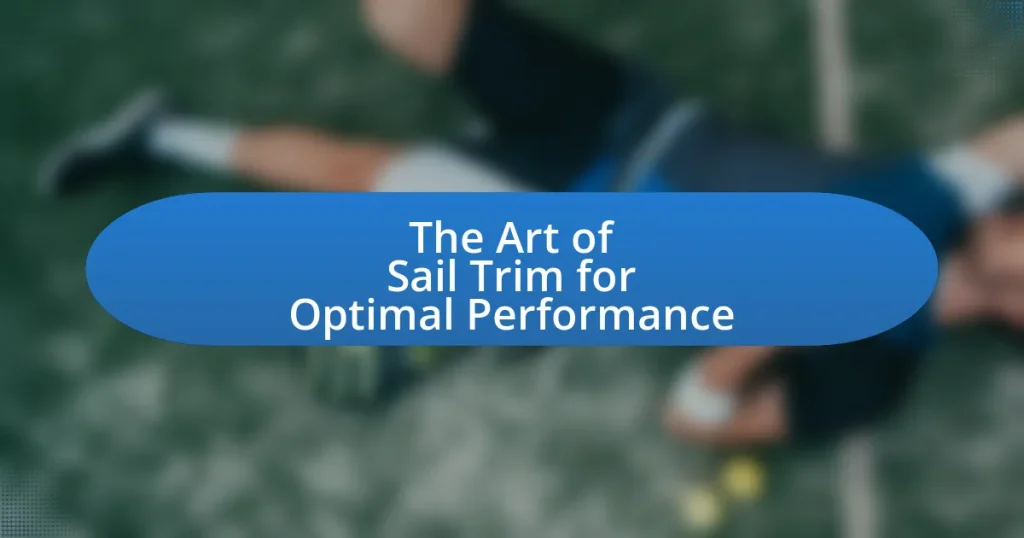The article focuses on the art of sail trim, emphasizing its importance for optimizing sailing performance across various wind conditions. It details how proper sail adjustments can enhance speed and maneuverability, with studies indicating improvements of up to 20% in boat speed. Key elements of effective sail trim, including sail shape, angle of attack, and balance, are discussed, along with specific techniques for adjusting sails in light and heavy winds. Additionally, the article highlights common mistakes in sail trimming, the role of technology and tools in optimizing performance, and best practices for maintaining optimal sail trim during races.

What is the Art of Sail Trim for Optimal Performance?
The art of sail trim for optimal performance involves adjusting the sails to maximize the efficiency of a sailing vessel in various wind conditions. Proper sail trim ensures that the sails are shaped correctly to harness wind power effectively, which can significantly enhance speed and maneuverability. For instance, when sailing upwind, sails should be trimmed flat to reduce drag, while downwind sailing requires fuller sails to capture more wind. Studies have shown that optimal sail trim can improve a boat’s speed by up to 20%, demonstrating its critical role in sailing performance.
How does sail trim influence sailing performance?
Sail trim directly influences sailing performance by optimizing the shape and angle of the sails to harness wind energy effectively. Proper sail trim allows a sailboat to achieve maximum speed and efficiency by adjusting the sails to the wind direction and strength, which minimizes drag and maximizes lift. For instance, when sails are trimmed correctly, they can create a more streamlined airflow, reducing turbulence and increasing the boat’s velocity through the water. Studies have shown that well-trimmed sails can improve a sailboat’s speed by up to 20%, demonstrating the critical role of sail trim in enhancing overall sailing performance.
What are the key elements of effective sail trim?
The key elements of effective sail trim include sail shape, angle of attack, and balance. Sail shape refers to the curvature and fullness of the sail, which affects lift and drag; an optimal shape is achieved by adjusting halyards and sheets. The angle of attack is the angle between the sail and the wind, which should be adjusted to maximize power without stalling; this is influenced by the sail’s trim and the boat’s heading. Balance involves distributing the forces on the boat to maintain a steady course, which can be achieved by adjusting the sails in relation to each other and the boat’s center of gravity. These elements are critical for maximizing performance and efficiency while sailing.
How does sail shape affect boat speed and handling?
Sail shape significantly influences boat speed and handling by determining how effectively the sail interacts with the wind. A well-shaped sail can optimize lift and reduce drag, leading to increased speed. For instance, a fuller sail shape generates more power in lighter winds, while a flatter sail shape is more efficient in stronger winds, allowing for better control and speed management. Research indicates that adjusting the sail’s camber and twist can enhance performance; for example, a study by the University of Southampton found that optimal sail shape can improve speed by up to 15% in specific wind conditions. Thus, the precise adjustment of sail shape is crucial for maximizing both speed and handling characteristics of the boat.
Why is sail trim important for different wind conditions?
Sail trim is crucial for different wind conditions because it directly affects a sailboat’s speed, stability, and maneuverability. Proper sail trim allows the sails to harness wind energy efficiently, optimizing performance across varying wind strengths. For instance, in light winds, sails should be trimmed flatter to maximize the surface area exposed to the wind, while in strong winds, sails need to be depowered by easing the trim to prevent excessive heeling and maintain control. Studies have shown that boats with optimized sail trim can achieve up to 30% better performance compared to poorly trimmed sails, highlighting the importance of adjusting sail settings according to wind conditions.
What adjustments should be made in light winds?
In light winds, sailors should adjust the sail trim to maximize efficiency and maintain speed. This involves easing the sails to allow for fuller shapes, which helps capture more wind. Additionally, reducing the tension on the outhaul and adjusting the boom angle can enhance sail shape, promoting better airflow. Properly positioning the center of effort by moving the sails forward can also improve performance in light conditions. These adjustments are crucial as they enable the vessel to harness the limited wind available, ensuring optimal sailing performance.
How should sail trim be modified in heavy winds?
In heavy winds, sail trim should be adjusted by flattening the sails and reducing their overall area to minimize heeling and maintain control. This involves tightening the outhaul and downhaul to reduce draft and using the vang to control the leech tension, which helps prevent excessive twist. Additionally, the sail should be trimmed in closer to the centerline to reduce the power generated by the wind. These adjustments are crucial as they help maintain balance and prevent overpowering the vessel, ensuring safer and more efficient sailing in challenging conditions.

What techniques are used in sail trimming?
Sail trimming techniques include adjusting the angle of the sails to the wind, controlling the tension of the sail controls, and optimizing the shape of the sails. These adjustments are crucial for maximizing speed and efficiency while sailing. For instance, the main techniques involve using the mainsheet, traveler, and halyards to fine-tune the sail’s position and shape according to wind conditions. Proper sail trim can lead to improved boat performance, as evidenced by competitive sailing practices where precise adjustments are made to achieve optimal speed and maneuverability.
How do you achieve optimal sail shape?
To achieve optimal sail shape, sailors must adjust the sail’s trim by controlling its angle to the wind and the tension on the sail’s various components. Properly trimming the sail involves setting the correct sail angle, which maximizes lift and minimizes drag, thus enhancing performance. For instance, adjusting the halyard tension affects the sail’s draft position, while the sheet tension influences the sail’s shape and curvature. Research indicates that optimal sail shape can significantly improve a vessel’s speed and efficiency, as demonstrated in studies conducted by the American Sailing Association, which found that well-trimmed sails can increase speed by up to 20%.
What role do telltales play in sail trim adjustments?
Telltales serve as visual indicators that help sailors assess the airflow over the sails, which is crucial for making precise sail trim adjustments. By observing the behavior of telltales, sailors can determine whether the sails are properly trimmed for optimal performance; for instance, if the telltales on the leeward side are streaming straight back, it indicates that the sail is correctly trimmed, while fluttering telltales suggest that adjustments are needed. This real-time feedback allows for immediate corrections, enhancing the efficiency of the sail and improving overall sailing performance.
How can you use the leech and luff to improve performance?
To improve performance using the leech and luff, sailors can adjust the tension and shape of the sail. Properly trimming the leech, which is the trailing edge of the sail, allows for better airflow and reduces drag, enhancing speed. Adjusting the luff, the forward edge of the sail, optimizes the angle of attack, ensuring that the sail captures wind efficiently. Research indicates that precise sail trim can increase boat speed by up to 20% in optimal conditions, demonstrating the significant impact of leech and luff adjustments on overall performance.
What are the common mistakes in sail trimming?
Common mistakes in sail trimming include over-trimming, which causes the sail to lose shape and power, and under-trimming, leading to excessive drag. Sailors often fail to adjust the sail for changing wind conditions, neglecting to ease or tighten the sheets as necessary. Additionally, improper use of the traveler can result in poor sail angle and reduced efficiency. These mistakes can significantly impact a vessel’s speed and handling, as optimal sail trim is crucial for maximizing performance on the water.
How can improper sail trim affect boat performance?
Improper sail trim negatively impacts boat performance by causing inefficient airflow over the sails, leading to reduced speed and maneuverability. When sails are not trimmed correctly, they can create excessive drag or insufficient lift, which hinders the boat’s ability to harness wind energy effectively. For instance, a study by the University of Southampton found that optimal sail trim can increase a boat’s speed by up to 20%, while poor trim can result in a significant loss of performance, demonstrating the critical importance of precise sail adjustments for maximizing efficiency on the water.
What are the signs of poorly trimmed sails?
Signs of poorly trimmed sails include excessive luffing, uneven sail shape, and poor boat speed. Excessive luffing occurs when the sail flaps or shakes, indicating that it is not properly tensioned or aligned with the wind direction. An uneven sail shape can be identified by bulges or wrinkles, which suggest that the sail is not balanced or that the halyard tension is incorrect. Poor boat speed is often a result of inefficient sail trim, leading to reduced performance and increased drag. These signs collectively indicate that adjustments are necessary to optimize sail trim for better sailing efficiency.

What tools and resources assist in sail trimming?
The primary tools and resources that assist in sail trimming include sail trim guides, telltales, and winches. Sail trim guides provide detailed instructions on adjusting sails for various wind conditions, enhancing performance. Telltales, which are small pieces of yarn or fabric attached to the sail, indicate airflow and help sailors make real-time adjustments for optimal sail shape. Winches facilitate the efficient handling of sail controls, allowing for precise tension adjustments. These tools collectively improve sail performance by enabling sailors to respond effectively to changing conditions, thereby maximizing speed and efficiency on the water.
How can technology enhance sail trimming techniques?
Technology can enhance sail trimming techniques by providing real-time data and analytics that optimize sail shape and performance. Advanced sensors and software can measure wind speed, direction, and sail angle, allowing sailors to make precise adjustments for maximum efficiency. For instance, systems like the Sailmon and Velocitek offer performance metrics that help sailors understand how to trim sails effectively under varying conditions. This data-driven approach leads to improved speed and maneuverability, as evidenced by competitive sailing teams that utilize these technologies to gain an edge in races.
What apps or devices are available for sail trim analysis?
Several apps and devices are available for sail trim analysis, including SailGrib, PredictWind, and the Velocitek ProStart. SailGrib offers features for wind and tide analysis, while PredictWind provides detailed weather forecasts and routing options. The Velocitek ProStart is a device that measures speed and provides real-time data to optimize sail trim. These tools are widely used by sailors to enhance performance by analyzing and adjusting sail settings based on precise data.
How do professional sailors utilize data for sail trim optimization?
Professional sailors utilize data for sail trim optimization by analyzing real-time performance metrics, such as wind speed, wind direction, and boat speed, to make informed adjustments to sail settings. This data-driven approach allows sailors to fine-tune the angle and tension of sails, maximizing aerodynamic efficiency and enhancing overall performance. For instance, using instruments like anemometers and GPS, sailors can gather precise information about environmental conditions and their vessel’s response, enabling them to adjust sail trim dynamically during races. This method is supported by studies showing that optimized sail trim can improve speed by up to 10% in competitive sailing scenarios.
What are the best practices for maintaining sail trim?
The best practices for maintaining sail trim include regularly adjusting the sails based on wind conditions, ensuring proper tension on the halyards and sheets, and monitoring the sail shape for optimal performance. Sailors should continuously assess the angle of the sails relative to the wind direction, making incremental adjustments to achieve the desired sail shape. For instance, flattening the sail in strong winds can reduce heeling and improve speed, while easing the sails in lighter winds can enhance power. Additionally, using telltales on the sails provides real-time feedback on airflow, helping sailors make informed adjustments. These practices are supported by sailing experts who emphasize the importance of dynamic sail management for maximizing efficiency and performance on the water.
How often should sail trim be adjusted during a race?
Sail trim should be adjusted continuously during a race to optimize performance. This involves making frequent, real-time adjustments based on changing wind conditions, boat speed, and course direction. Research indicates that effective sail trim can improve speed by up to 20%, highlighting the importance of constant monitoring and adjustment throughout the race.
What routine checks can ensure optimal sail performance?
Routine checks that can ensure optimal sail performance include inspecting the sail for wear and tear, checking the rigging for proper tension, and ensuring that all lines are free of tangles and chafing. Regularly examining the sail for any signs of damage, such as tears or UV degradation, is crucial as these issues can significantly affect performance. Additionally, verifying that the rigging is correctly tensioned helps maintain the sail’s shape, which is essential for efficient sailing. Ensuring that sheets and halyards are not twisted or frayed prevents loss of control and enhances responsiveness. These checks are vital for maintaining the integrity and functionality of the sail, ultimately leading to improved sailing performance.
What practical tips can improve your sail trimming skills?
To improve your sail trimming skills, practice adjusting the sail shape based on wind conditions and boat speed. Regularly observe the sail’s luffing and the telltales to gauge airflow; for instance, when the wind is strong, flatten the sail to reduce heeling. Additionally, familiarize yourself with the effects of different sail controls, such as the outhaul, cunningham, and backstay, as they directly influence sail shape and performance. Studies show that sailors who actively adjust their sails in response to changing conditions can achieve up to 20% better performance in races.


